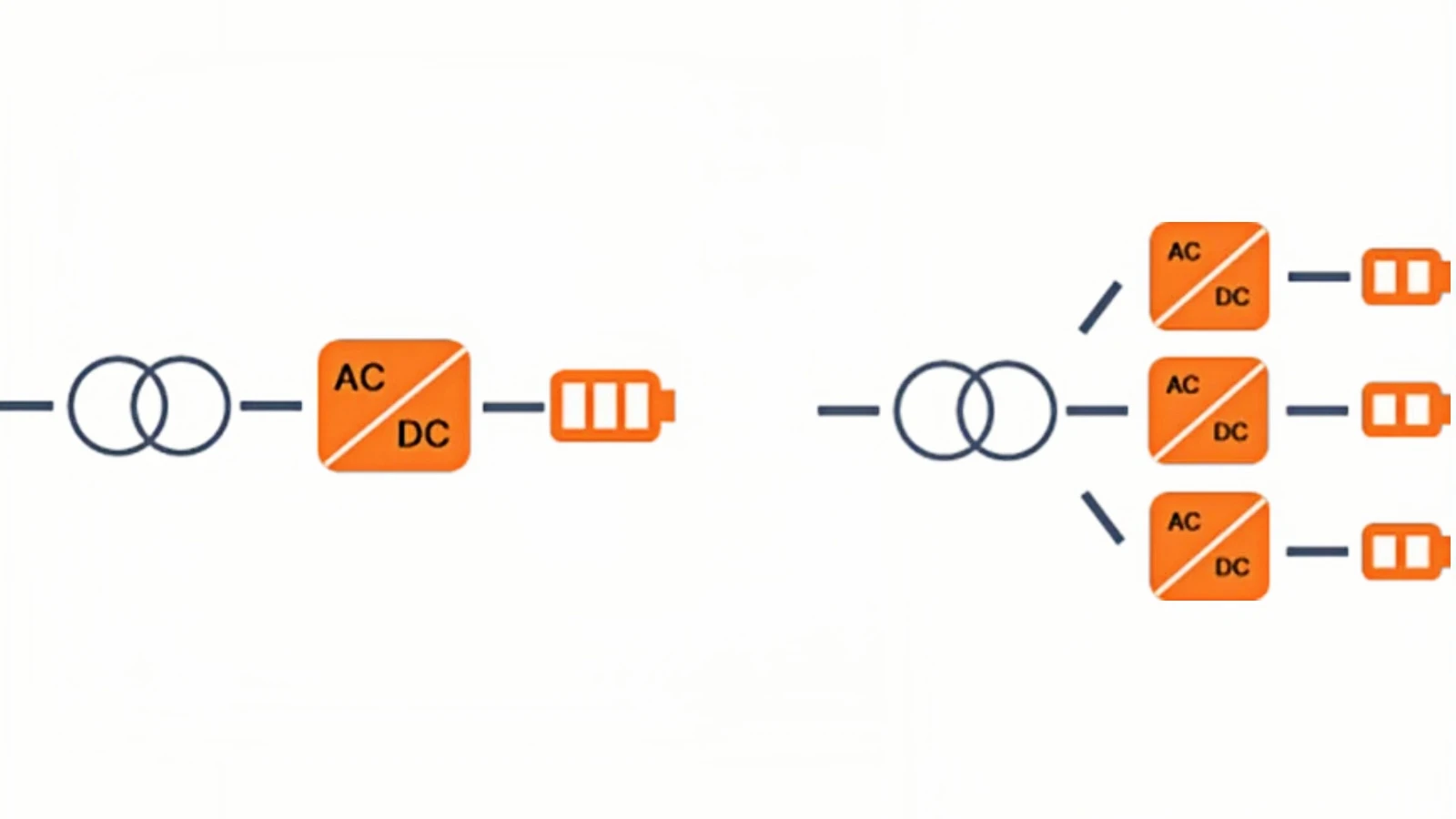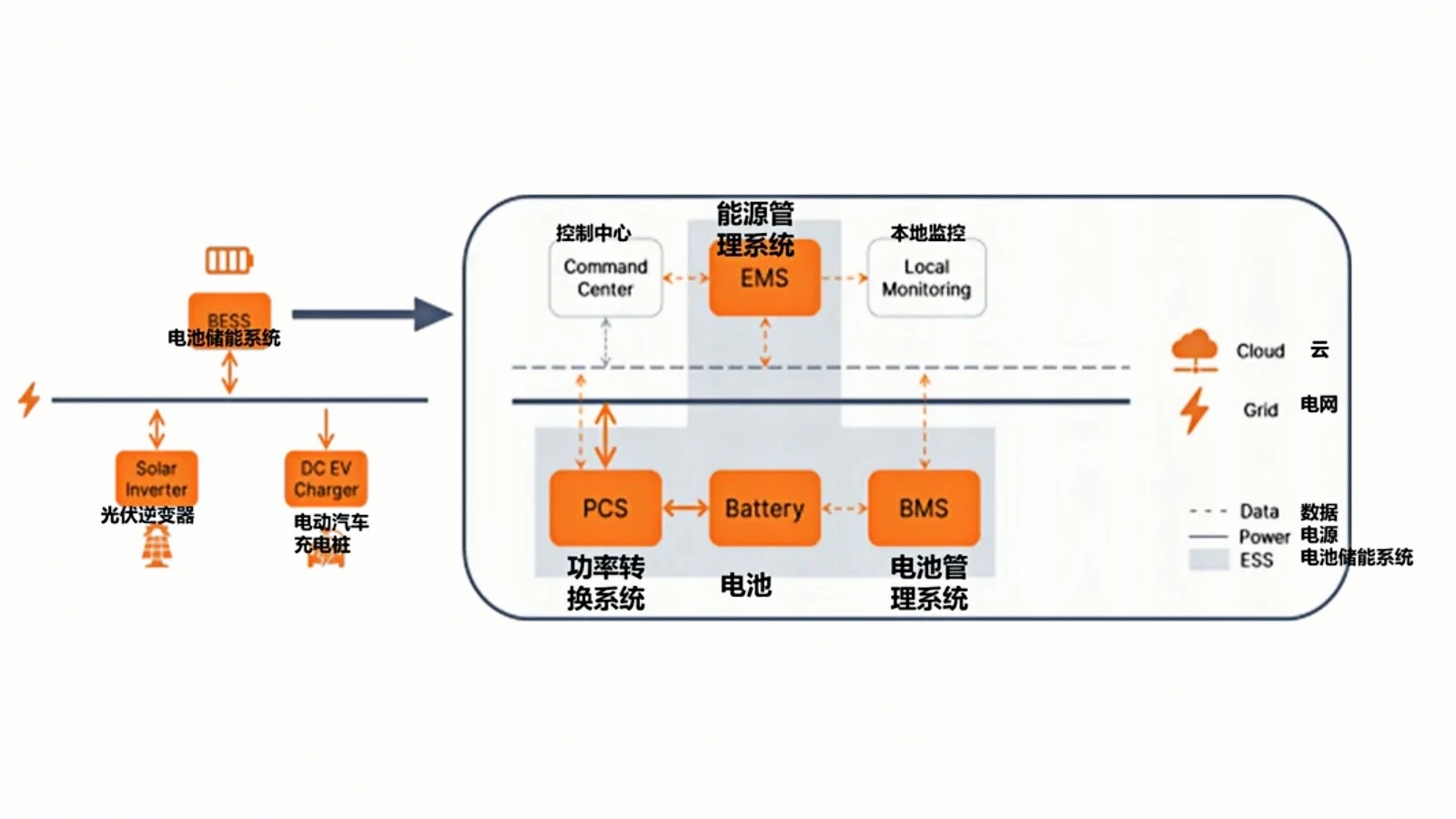Battery Energy storage systems (BESS) are revolutionizing the path toward a low-carbon future, emerging as one of the most dynamic and rapidly evolving industrial sectors. Propelled by ambitious global decarbonization goals, the surging adoption of renewable energy like solar PV, and the dramatic decline in lithium-ion battery costs, BESS technologies are transforming the way we generate, store, and use energy. Their seamless integration with solar PV systems and EV charging networks highlights their indispensable role in shaping the energy ecosystems of tomorrow.
1. System Objectives: Why BESS Matters
ESS technologies enable efficient energy storage across diverse sources—coal, nuclear, wind, and solar—using methods like electrochemical (batteries), mechanical (compressed air), and thermal (molten salt) storage. This guide focuses on battery energy storage systems (BESS) paired with solar inverters, a cornerstone of residential and commercial decarbonization.
Residential Applications:
Backup Power During Outages: Battery energy storage systems (BESS) provide reliable backup power, ensuring uninterrupted energy supply during grid failures caused by storms, natural disasters, or maintenance.
Cost Savings via Energy Arbitrage: Homeowners can store energy during off-peak, low-cost periods and use it during expensive peak hours, reducing electricity bills and maximizing savings.
Commercial Applications:
Managing Surplus Solar Energy: Businesses can store excess solar energy generated during the day and utilize it later, reducing dependency on the grid, lowering operational costs, and contributing to sustainability goals by cutting carbon emissions.
Mitigating Grid Strain from EV Charging Demand: With the rise in electric vehicle (EV) adoption, BESS helps balance the increased load on the grid by storing energy and releasing it during high-demand EV charging periods, ensuring grid stability.
Lithium-ion batteries dominate the BESS market due to their superior energy density, scalability, and rapidly decreasing costs. Since 2013, prices have dropped by 80%, driven by advancements in technology and economies of scale (source: BloombergNEF). This makes them an increasingly viable option for both residential and commercial applications.

2. Market Trends & Outlook
Explosive Growth in BESS Demand
Global BESS capacity is forecasted to skyrocket from 45 TWh in 2022 to an astounding 552 TWh by 2030, reflecting a remarkable 37% CAGR under the IEA Stated Policies Scenario.
Lithium-ion battery prices have plummeted to a historic low of $107/kWh in 2023, unlocking unprecedented opportunities for cost-efficient, large-scale grid applications.
The addition of over 800 GW of new solar capacity by 2030, as projected by the IEA, is set to fuel soaring demand for advanced and integrated energy storage solutions.
Higher Voltage & Power Density
The adoption of 1500V systems has become the standard in commercial solar inverters, significantly reducing current and associated losses while allowing for the use of slimmer, more cost-effective cabling.
Key Design Challenges:
Optimal component selection: Choosing between 1200V multi-level designs or advanced 2000V SiC MOSFETs to meet the demands of high-voltage topologies.
Ensuring safety and minimizing EMI: Addressing critical safety measures and electromagnetic interference mitigation for reliable operation in high-power systems.
Distributed & Intelligent Systems
Decentralized BESS: Revolutionizing energy storage by eliminating battery imbalances, significantly extending battery lifespan, and streamlining maintenance processes. A smarter, more reliable alternative to centralized systems.
Energy Management Systems (EMS):
Seamlessly enabling real-time monitoring and grid coordination for enhanced performance, including peak shaving and solar energy integration.
Unlock the power of AI and big data for predictive maintenance, operational efficiency, and unprecedented energy optimization.

Centralized vs. distributed solutions
Ecosystem Integration with Solar & EV Charging
Commercial Solutions:
BESS paired with solar inverters reduces grid dependency and enables energy arbitrage.
Mitigates harmonic distortions and transformer overloads from EV charging stations.
Residential Solutions:
Lowers peak demand charges and provides backup power during outages.
3. System Implementation: Core Components & Design
Four Pillars of a BESS
Battery Pack: Lithium-ion cells configured for high voltage (50V–1100V) and capacity.
Battery Management System (BMS): Ensures safe operation, monitors state-of-charge (SOC), and extends lifespan.
Power Conversion System (PCS): Bidirectional inverters for grid/battery energy transfer.
Energy Management System (EMS): Optimizes performance via grid coordination and real-time analytics.
AC-Coupled vs. DC-Coupled Systems
Battery energy storage systems are currently divided into two categories, namely AC-coupled systems and DC-coupled systems.
AC-Coupled:
- Pros: The AC-coupled battery energy storage system is a standalone system that can be added to an existing PV/generation system/grid, making it easy to upgrade.Simplifies the integration of battery storage into existing solar or grid-tied systems, making it ideal for retrofitting. Allows for the use of separate inverters for solar panels and batteries, offering flexibility in system design.
- Cons: Increased energy losses due to multiple AC/DC and DC/AC conversion stages, which can reduce overall system efficiency. May require additional components, leading to higher initial costs.
AC-Coupled
DC-Coupled:
-Pros: the DC-coupled system can provide additional energy storage capabilities by connecting to the DC bus, and is typically used in residential hybrid PV inverters.Higher efficiency due to single DC-DC conversion, which minimizes energy losses and enhances overall performance for hybrid solar inverters, especially in systems with varying power demands.
-Cons: Safety challenges associated with high DC bus voltages, including increased risks of electrical arcing, insulation breakdown, and stricter compliance requirements for safety standards.
DC-Coupled
Bidirectional Operation
PCS Requirements:
Three-phase inverters are essential to support reverse power flow, enabling seamless operation in both grid-to-battery and battery-to-grid scenarios, ensuring system flexibility and reliability.
Topology optimization is critical, as advanced switching strategies and precise component selection (e.g., SiC over IGBT) significantly enhance system efficiency and performance.
For instance, a well-designed bidirectional DC-AC inverter often demonstrates superior performance in discharge mode compared to charge mode, highlighting the importance of tailored engineering.
4. Silicon Carbide (SiC): Revolutionizing Power Electronics
SiC devices are increasingly becoming the preferred choice for high-voltage PCS designs due to their superior performance and cost-efficiency:
High-Frequency Switching: Enables a 30–50% reduction in passive component sizes (e.g., inductors, capacitors), leading to more compact and lightweight designs.
Lower Losses: Achieves 3–5% higher efficiency compared to traditional IGBTs in systems operating at 1500V or higher, significantly enhancing energy savings.
Thermal Resilience: Capable of operating at temperatures exceeding 200°C, thereby reducing the need for extensive cooling systems and lowering overall thermal management costs.
Design in Action:
A bidirectional A-NPC inverter demonstrates the strategic use of SiC MOSFETs in the inner branches to minimize switching losses, while cost-effective IGBTs are utilized for the outer switches. This hybrid approach optimizes both performance and budget, showcasing the practical advantages of SiC technology.
Final Thoughts: The Road Ahead
Scalability: The future belongs to modular energy solutions like Tesla Powerwall and Sungrow ESS, poised to revolutionize residential and commercial markets with unmatched adaptability.
Smart Integration: Imagine AI-driven Energy Management Systems and digital twins working seamlessly to slash lifecycle costs and enhance grid efficiency like never before.
Regulatory Alignment: Staying ahead means mastering compliance with essential standards like UL 9540, IEC 62443, and NFPA 855—setting the benchmark for safety and reliability.
The future of energy storage critically depends on groundbreaking innovation, seamless interoperability, and well-forged strategic partnerships. As Battery Energy Storage Systems (BESS) solidify their role as the cornerstone of renewable energy grids, engineers and developers must place unwavering emphasis on maximizing flexibility, enhancing efficiency, and ensuring uncompromising safety.
Copyright © 2024.Company name All rights reserved.
*We respect your confidentiality and all information are protected.